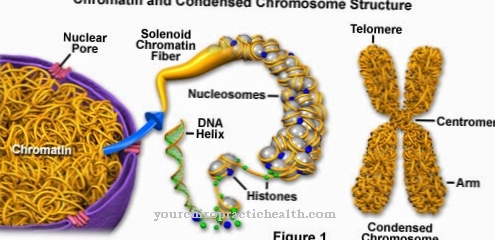Under Melanins medicine understands the body's own pigments that give the skin, hair and eyes their color. The melanins are produced in the so-called melanocytes and released to the surrounding cells. In pigmented people, the pigment takes on the role of a UV filter.
What are melanins?
Melanins are reddish, black, and brown pigments. In humans, they color the eyes, skin and hair. Melanins are also found in animals. In the animal kingdom, they determine the color of fur and feathers. In squids, they also form the dye in the ink. An enzymatic oxidation takes place to form melanins. The starting material for this reaction is what is known as tyrosine.
In vertebrates, the biosynthesis for the production of melanins takes place in the basal cell layer of the epidermis and in the retina of the eyes. The producing cells are also called melanocytes and transport the pigments via their dendrites to the surrounding keratinocytes. In humans, melanin comes in two different varieties. While the pheomelanin has a brownish red color, the eumelanin is brownish black. Different colored variants are also known as allomelanins and are found in bacteria, fungi and plants.
Anatomy & structure
In human skin and in human hair, melanins are present as mixed forms of eumelanins and phaeomelanins. The proportions of the two subgroups together with other factors determine the skin type of the person. People with bright red hair, light skin and freckles, for example, have a particularly high content of pheomelanins. In contrast, eumelanins predominate in black hair and dark skin. Eumelanin is produced by the oxidation of the amino acid tyrosine.
These melanins are therefore derivatives of the same synthetic pathway that the dopamine precursor L-Dopa travels through. Phaeomelanin, on the other hand, contains sulfur. Allomelanins as found in plants and microorganisms are obtained from hydroxylbenzenes. In most cases, melanins are protein-bound or at least linked to lipids.
Function & tasks
According to today's medicine, melanins primarily serve to protect against UV radiation. This assumption is based on the observation that dark-skinned people are significantly less likely to develop malignant melanoma and thus black skin cancer. In addition to the stimulating hormone, solar radiation also stimulates the production of melanin in the melanocytes. It has been proven that melanin can act as a UV filter.
The radiation energy is transformed into mere heat in an internal transformation. The electronically excited state of molecules is transformed into vibrational states during the internal transformation. Around 99 percent of the radiation energy can be rendered harmless in this way. The life of the molecule in the excited state is shortened and free radicals cannot form in this way. Since redheads with pale skin are at a much higher risk of skin cancer than pigmented people, sun protection is probably less effective due to their melanin type.
The pigments are produced in the rough endoplasmic reticulum of the melanocytes. The amino acid tyrosinase is stored in the Golgi apparatus of the melanocytes and constricted in vesicles. Tyrosine migrates into these vesicles and a maturation process begins. With the help of a protein, tyrosinase becomes DOPA and finally melanin. A mature melanosome migrates into the dendrites of the melanocytes and is released to the five to eight surrounding cells. This process is activated by UV radiation or the hormone MSH.
You can find your medication here
➔ Medicines against redness and eczemaDiseases
Hyperpigmentation is overpigmentation of the skin. In this disease, excessive amounts of pigment accumulate in the epidermis. Either only parts of the skin are affected or the entire body. The stored dyes can either be the body's own dyes or exogenous pigments. Exogenous deposits occur, for example, with the carbon deposits from tattoos. A special form of hyperpigmentation is the post-inflammatory form.
The melanocytes are not activated by sunlight, but rather by enzymes as part of local inflammation. The opposite of hyperpigmentation is called hypopigmentation. The formation of the pigment melanin is disturbed in the context of many hypopigmentations. In albinism, for example, disturbances in the biosynthesis of melanin occur. An intermediate product of melanin biosynthesis loses its functionality and the conversion to melanin is disturbed. Congenital hyperpigmentation, on the other hand, is known as a birthmark. Birthmarks can either appear well-defined or irregular. With clearly defined birthmarks there is usually no risk of degeneration. Diffuse birthmarks or those with an extremely dark color, on the other hand, tend to degenerate.
They can develop into melanoma, which is black skin cancer, over time. Black skin cancer is a malignant tumor of the melanocytes that spreads metastases through the lymphatic system and the blood system. In more than half of all cases, a melanoma develops from an irregular nevus cell nevus. Malignant melanomas don't just happen on the skin. Such structures can also develop in the mucous membranes of the internal organs or on the conjunctiva.
These mucosal melanomas, however, are far less common than skin melanomas. Fair-skinned people are at a much greater risk of developing melanoma on their skin because they do not have a UV filter. In contrast, pigmented people often develop mucosal melanomas because their mucous membranes and conjunctiva are not pigmented and therefore not UV-protected.
























.jpg)



